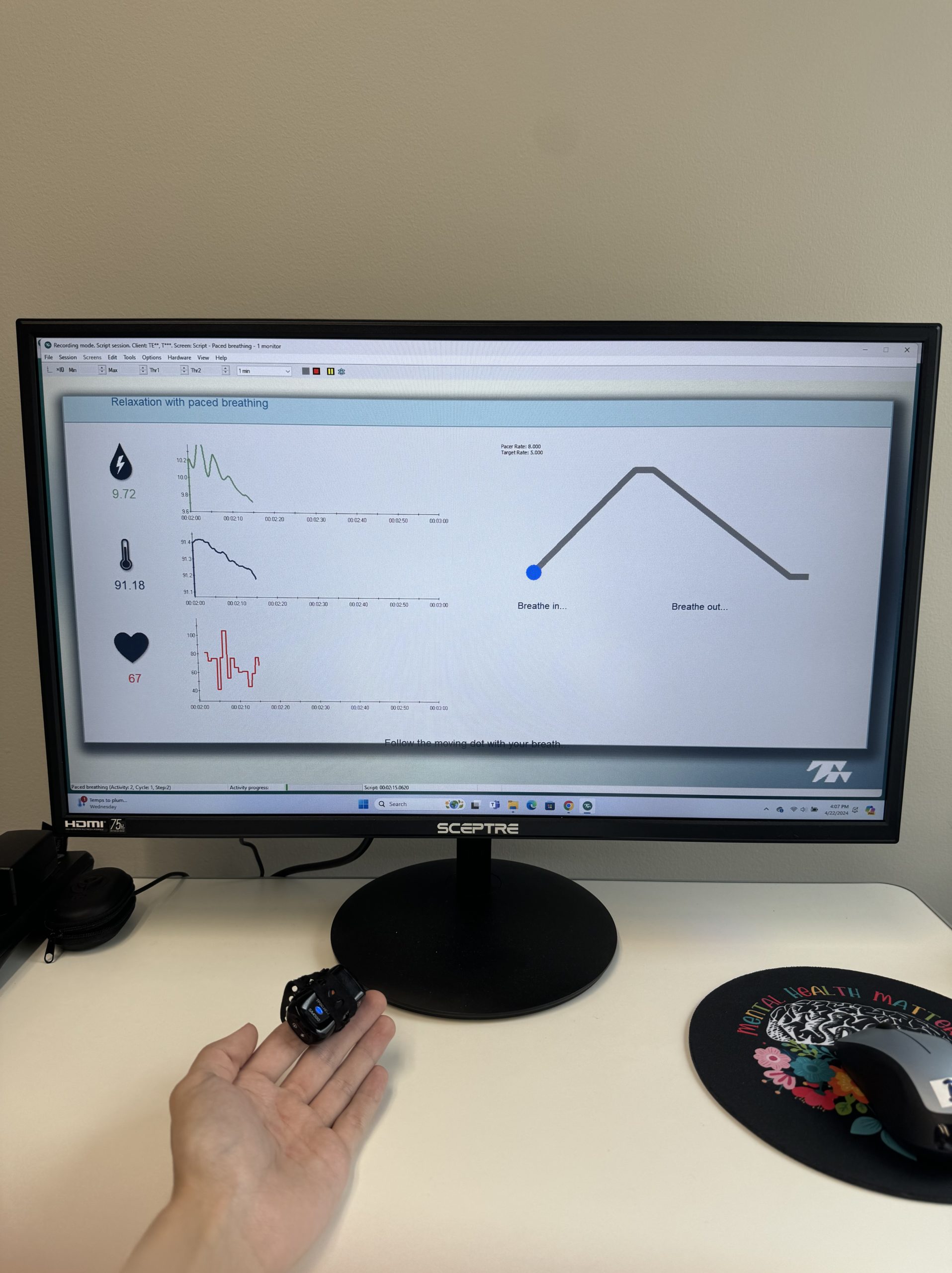Does your stress and anxiety ever lead you to feeling sweaty, tense, dizzy, or uncomfortable? Do you ever wish you could control your body’s response to stress? If you said ‘yes’, then biofeedback training may be the right service for you!
Biofeedback is a mind-body technique designed to help you gain greater insight into your physiological state. Using our technology driven approach, we’ll teach you to recognize how presenting issues impact your physical and emotional well being and equip you with the skills and experience necessary to control certain bodily functions.

What conditions can biofeedback treat?
Studies show biofeedback may improve the following presenting issues & diagnoses:

What does a biofeedback session look like?
During a biofeedback session, our technician or clinical supervisor will attach a single small sensor to the tip of your finger. The sensor records basic physiological data such as:
During breathing biofeedback we’ll track your breathe rate and teach you a simple diaphragmatic breathing technique. Training may help with stress management, anxiety, asthma, or other stress-related conditions’ symptoms. This technique is foundational to the many biofeedback trainings done here at Jeena Jacob Inc. and will serve as a starting point for any interested in pursuing our biofeedback services.
During HRV biofeedback we’ll track your breathe & heart rate to calculate your heart rate variability, or HRV, for short. HRV is the total difference in time intervals between heartbeats. Extensive research has demonstrated that increasing HRV improves physical and emotional self-regulation. How we increase our HRV is by breathing at a specific rate known as resonance frequency. Each individual is unique, and thus so is there resonance frequency. Over a couple sessions we’ll calculate yours and begin training you to breath at this rate. HRV training may be especially helpful to those with stress, anxiety, depression, PTSD, and chronic pain.
During temperature biofeedback training we’ll teach you how to control your bodily temperature through diaphragmatic breathing. When experiencing stress, blood is directed towards our central organs and muscles which lowers the temperature around our limbs. You may recognize this process as the “fight or flight” response. In the case of many anxiety disorders this response fires too often, too long, and too easily. By exercising diaphragmatic breathing, we are able to “switch-off” our stress response and induce a calm and relaxing state which we measure by recording your peripheral bodily temperature. This training may be beneficial if you experience stress, anxiety, or muscle tension. Additionally reported positive effects include improved overall mood and improved concentration.
Galvanic skin response, or GSR, is the measurement of perspiration/sweat coming off the body which queues us into an individual’s emotional state. When we experience stress this value often increases and when we are relaxed, it often lowers. During a GSR biofeedback session we’ll teach you how to diaphragmatically breath in a manner that lowers your GSR and help you maintain a calm state. This training may be helpful for those with anxiety, stress, or phobias.
A computer analyzes and processes the physiological data and reports it back to you in a form of feedback. Feedback may come in following forms:
Visual feedback may appear as dynamic graphics or videos that help you measure your progress. Depending on your goal, your objective may be to reach a specific temperature, lower your sweat level below a certain threshold, or fill a bar graph.
Auditory feedback comes in the form of pleasant sounds, quietness, or changing pitches that queue you into your performance levels. For example, pleasant sounds may mean you’re achieving certain results whilst silence may mean you’re performing below expectations.
As you experience feedback, our technician or clinical supervisor teaches you what the feedback means and help you adjust your strategies and techniques towards achieving your specific goals.
If you’d like more information, please visit our Additional Resources and FAQs pages.






How many sessions will I need?
Since biofeedback is like a training regiment, it will take time and effort to learn. You’ll be expected to attend multiple sessions and be an active participant in the training process. You can expect at least 10-15 sessions, preferably once per week. However, the number of sessions required varies widely depending on:
- Symptom(s) / diagnosis of issue
- Severity of symptoms
- Bodily response to biofeedback
- Amount of training / practice allocated to biofeedback
We’ll work with you to discuss your treatment goals, directions, and what we expect of you to succeed.
Can I practice biofeedback at home?
Yes, and we suggest doing so. Practicing at least 15 minutes per day can go along way in the treatment process and we recommend to all our clientelle to practice whether at our clinic, home, or work. Once you’ve learnt the essential skills here, you can hold your own sessions at home. For your practice at home, we recommend purchasing a stress thermometer and to download this adjustable breath rate app from Apple’s App Store or Google Play Store. This app is only one of many options, so choose whatever feels right for you!

